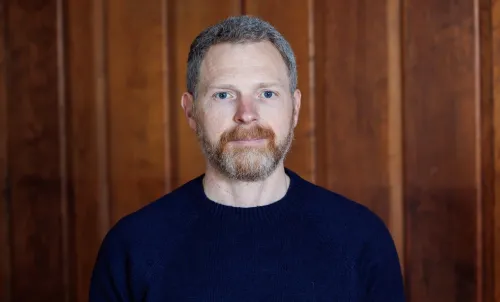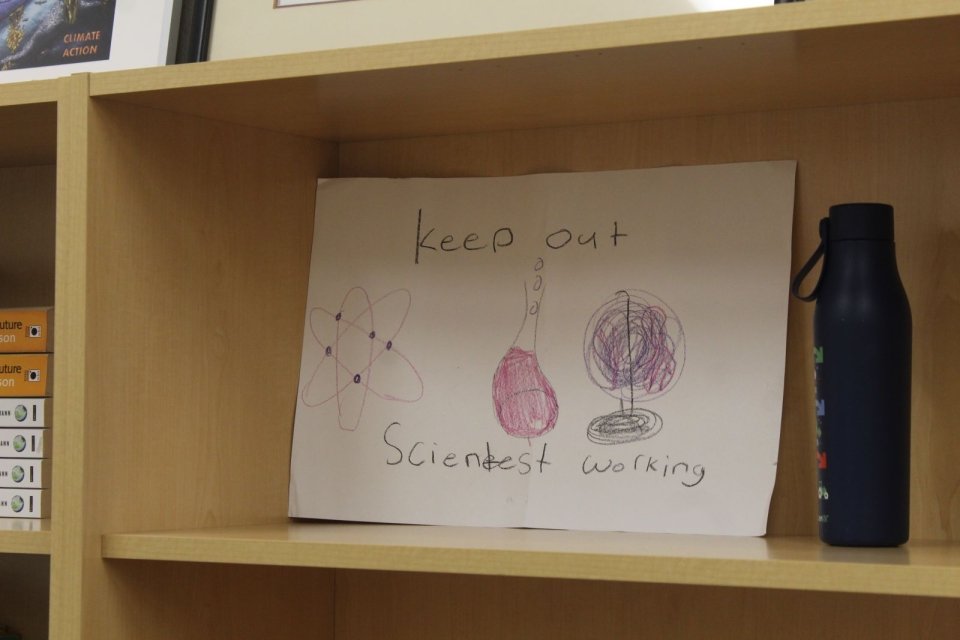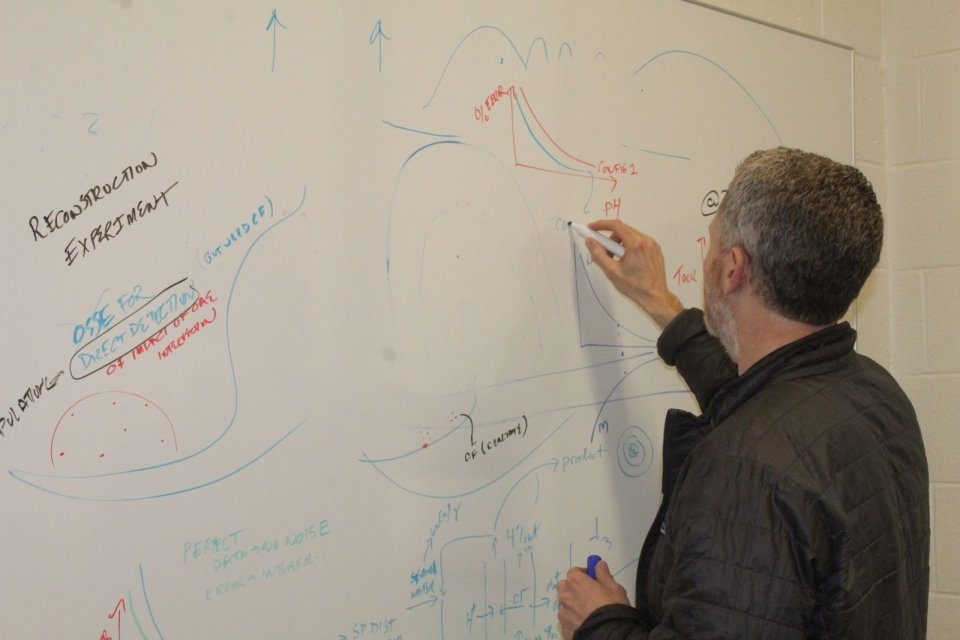Meet the FAS Faculty: Matthew Eisaman
Matthew Eisaman, Associate Professor of Earth and Planetary Sciences in Yale’s Faculty of Arts and Sciences, researches climate change and ocean carbon dioxide removal.

When Matthew Eisaman invites you into his office, among the textbooks on his bookshelf you’ll find a sign created by his then-nine-year-old daughter that reads: “Keep out, scientist working.” It is an apt warning for visitors, as Eisaman is constantly working towards a better future through his research on addressing global warming through carbon capture.
Eisaman is Associate Professor of Earth and Planetary Sciences in Yale’s Faculty of Arts and Sciences, as well as a member of the Scientific Leadership Team at the Yale Center for Natural Carbon Capture (YCNCC). Before joining Yale in 2023, he served as an Associate Professor at Stony Brook University with a guest appointment at Brookhaven National Lab in Upton, New York – one of 10 national laboratories overseen and funded by the U.S. Department of Energy’s Office of Science.
Eisaman’s journey to climate research wasn’t linear. In college, he began his studies with the goal of working in astrophysics. However, over the course of his education (he earned his A.B. in Physics from Princeton in 2000 and his Ph.D. in Physics from Harvard in 2006), he narrowed his focus to the Earth’s natural systems for removing carbon dioxide from the atmosphere, with an emphasis on the ocean.

Eisaman was also an Applied Physicist in the Cleantech Innovation Program at Xerox’s Palo Alto Research Center (PARC), where he researched how electrochemistry can be harnessed for carbon dioxide removal. That experience fueled his passion for finding and scaling climate solutions and directed his subsequent research.
His current research primarily focuses on removing carbon dioxide from the atmosphere, a task that brings physics together with other hard sciences like chemistry, oceanography, and chemical and environmental engineering. “I really like that carbon capture research brings together multiple fields to solve an important problem,” he said, especially when that research can then be applied to real-world technologies quite quickly.
“We’re thinking about how we can use the oceans to actively remove carbon dioxide from the air and store it in the ocean,” he said, because the ocean is one of the planet’s largest carbon “sinks,” or sites where carbon dioxide can be removed from the atmosphere and stored.
The ocean’s absorption of carbon dioxide can be explained at a molecular level. Earth’s hydrologic cycle – the continuous circulation of water through the land, ocean, and atmosphere – creates a natural method of carbon removal known as enhanced mineral weathering. As it rains, the carbon dioxide dissolved in the rain drops increases the rate at which the rain erodes rock. This process binds the carbon dioxide within “bicarbonate ions,” dissolved in the rainwater runoff, and when this runoff eventually enters the ocean, the bicarbonate ions have effectively removed carbon dioxide from the atmosphere and stored it durably in the ocean.
“The process we are researching makes a slight change to the ocean’s chemistry. That mixes in the ocean and goes out into the world over weeks or months, and carbon dioxide is removed as a result.”
Another project Eisaman is working on is Monitoring, Reporting, and Verification, or MRV, a measurement used to verify the amount of carbon dioxide removed from the atmosphere. He is also creating tools to verify and more accurately measure the amount of carbon captured by the ocean. “On geological timescales, the Earth has natural carbon dioxide regulation mechanisms and systems, but those work on timescales of millions of years,” he explained. “Obviously, we can’t wait that long, so we’re trying to accelerate that process.”
The goal of keeping the increase in the average global temperature to less than 2 degrees Celsius – a benchmark set out by the international Paris Agreement in 2015 to avoid the worst impacts of climate change – may seem daunting. But Eisaman is steadfast in the face of the challenge: “We can do it, but we need to really act now.”
That declaration encapsulates one of the core challenges of Eisaman’s field: researchers need to balance both “urgency and thoroughness,” he says. It is vital to have adequate time to study the problem and develop effective and efficient solutions, but society increasingly needs scientists to do so at an accelerated pace.
“We’re at the stage in the carbon dioxide removal field where people are developing lots of different approaches, and we need to very quickly assess which of these are effective and scalable so that we spend our energy deploying the right things.”
Initially brought to Yale University by the Yale Center for Natural Carbon Capture, which hired four new faculty to contribute to carbon capture research and innovative environmental projects last year, Eisaman has seen and appreciated the “interdisciplinary nature” of carbon capture research at Yale.
“I’m glad to be here, and I think the Center is creating a critical mass of people working on this problem at Yale, which is really nice,” he said. “I have lots of collaborations with colleagues here who are all working on related but slightly different areas.”

Although Eisaman began his research at Yale in July 2023, he did not begin to teach until last spring. While teaching an undergraduate seminar, “EPS 102, Understanding Climate Change Solutions” and a graduate seminar, “EPS 740, Seminar in Decision Support for Climate Change Solutions,” he saw firsthand the innate curiosity and high engagement of Yale students.
Eisaman’s classes encourage students to understand both the challenges and benefits of different climate solutions inside and out—so much so that students end up teaching each other. During the first few lectures, Eisaman introduces the subject by contextualizing the field. Then, students must become the lecturer: each week, different members of the class present on a topic, using the corresponding readings to lead a group discussion on the material.
His experience with students extends to the lab, which Eisaman is working on expanding. Currently home to one postdoc and four students, including two incoming graduate students in the fall, Eisaman recruits a variety of students to foster comradery and peer mentorship. “I think it’s important to have a mix of different experience levels, such as postdocs, grad students, and undergrads because they are learning from each other.”
Eisaman is not only busy instructing and mentoring students—his work is bolstering the future of carbon capture research at Yale.
Last October, the Yale Center for Natural Carbon Capture (YNCC) and the Yale School of the Environment were awarded $5M by the US Department of Energy (DOE) Earthshot Initiative. Under the DOE’s “Carbon Negative Shot” initiative, Yale researchers will examine the ability of natural carbon-capture methods to reduce global warming alongside researchers from the Georgia Institute of Technology, Princeton University, and Texas A&M University.
Eisaman is one of the researchers on the Yale research team. It’s led by Yale School of the Environment (YSE) Professor of Ecosystem Ecology Peter Raymond, and also includes James Saiers, YSE Clifton R. Musser Professor of Hydrology; EPS Professor Noah Planavsky; and EPS Assistant Professor Juan Lora.
With all these developments, the field of natural carbon capture has never been more exciting.
“I like working on problems that are intellectually interesting, but also meaningful. There’s this daunting challenge ahead of us, which is part of what makes it motivating, right? And I get to think about all these different systems interacting, which is what makes it fun.”